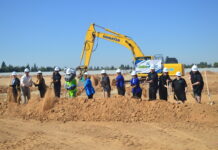
Water, timber, mineral and the scenic beauty of the Sierra Nevada provided a significant economic base for early day Clovis. California was booming and lumber was needed. The San Joaquin Valley Railroad arrived in Clovis in 1891 and the flume in 1893. Both created new markets for ranchers, farmers and the lumber industry.
The rugged terrain and canyons made logging in the Sierra unprofitable until the V-flume arrived. It was an unconventional man-made “river.” The V-type flume (two flat boards joined together at right angle) was invented in 1859 by J.W. Hines.
In 1890, the Big Dry Creek Flume and Irrigation Company was formed by pioneer families Sample, Letcher, Heiskell, Miller and Davis. They built an earthen dam on Stevenson Creek, created a lake, built a box flume with a V-flume above it that would carry water and lumber from Shaver to Tollhouse. The water from the box flume would then be diverted to Big Dry Creek and sold to ranchers.
The Miller and Lux Company controlled 22,000 square miles of cattle and farmland in California, Nevada and Oregon. In 1894, it filed an injunction that prohibited the flume company from delivering water to Big Dry Creek but it was agreed that the flume could continue to ship lumber. In was not until 1908 that the name of Fresno Flume and Irrigation was changed to Fresno Flume and Lumber Company.
In 1891, the flume was sold to Frank Bullard and others from Yolo County. It was reorganized under the name Fresno Flume and Irrigation. In 1892, Michigan lumbermen, L.P. Swift and C.B. Shaver and local pioneers, Bullard, Musick, Butler and Colson purchased the project.
Shaver and his brother-in-law Swift built a sawmill adjacent to the dam. Freight wagons, pulled by 36 horses, were used to transport mill equipment up Tollhouse Road. The steepest section required heavy equipment to be moved by block and tackle. Tollhouse Road was aptly named “the beast killer.”
The first earthen dam washed out during the spring flood of 1892. It was replaced by a rock dam 60 feet high in 1893. It is still visible when Shaver Lake water level is low.
John A. Eastwood (Fresno’s first city engineer) designed the V-shaped flume. It was made of cedar planks, 16 feet long and 16 inches wide by 1 1/2 inches thick. It was assembled in units called “boxes.” A total of 320 boxes equaled one mile.
Trestles (90 feet high at Musick Crossing) supported the flume. Adventurous men were lowered in baskets as they crossed canyons and cliffs to drill holes into the rock to secure the trestle. Once the trestle was in place, the crew built the V-shaped trough and a 16-inch catwalk. Material would be transported via the completed flume to continue the project.
Shaver Lake is 5,275 feet above sea level. The flume dropped 4,900 feet (27 ½ feet per mile) as it descended 42 miles to the property now occupied by the Clovis Rodeo Association and the C. Todd Clark Intermediate School. The 60 acres were originally purchased from Clovis Cole. The change in grade required the trestle to be raised to 15 feet at the mill site. Water from the flume was piped under Clovis Avenue and flowed west on Sixth Street (Bullard) to Willow Avenue.
The total project cost $270,000. Fresno was originally considered for the terminus of the flume but real estate was “too high.” Our flume was the third longest in the world. Both Sugar Pine Flume to Madera and the Millwood Flume to Sanger were 54 miles long.
A dozen flume-tender houses (connected with a single telephone line) were placed along the flume route to relay any problems. The men would use a pickaroon (a pole with a straight spike on the end with a crook beneath) to release any lumber “jams” as they walked on the 16-inch catwalk.
V-shaped boats would carry supplies and/or six to eight riders down the flume. The boat would reach a speed of 60 miles per hour at “slick rock” and would slow to five or six miles per hour from Academy to Clovis. It would take approximately seven hours for the trip.
Shay locomotives would bring logs to the millpond. Steam powered donkey engines would power the double circular saw to cut the huge logs. It is estimated at peak production 200,000 feet of rough lumber (sugar pine, ponderosa and fir) would arrive from Shaver to Clovis daily. A total of 400 men were employed in Clovis during the most productive years of the mill.
A large snowstorm in 1914 destroyed two miles of the flume and it was not rebuilt. The lumber mill remained a major industry in Clovis until 1925. It is an important part of our heritage.







